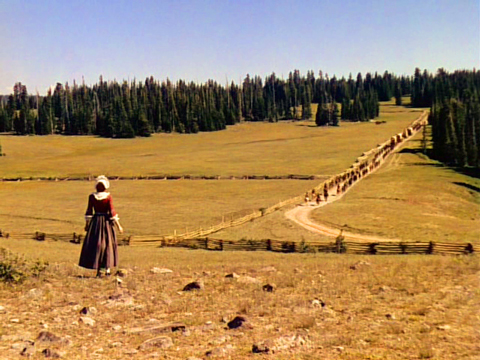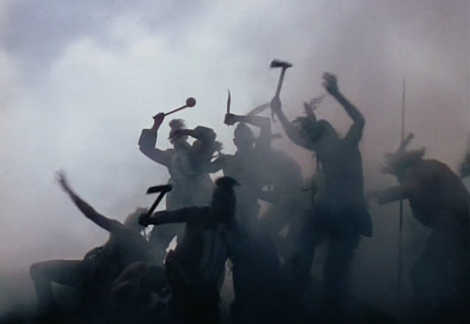|
|
Reviewed by Glenn Erickson
For John Ford the late 1930s were the years of his greatest success. The director had already chronicled the building of the transcontinental railroad (The Iron Horse) and the case of the unfortunate Dr. Mudd (The Prisoner of Shark Island). Drums Along the Mohawk became his second history-themed feature with Henry Fonda, made directly after Young Mr. Lincoln. Filmed in brilliant Technicolor, Mohawk is only 104 minutes in length yet has the feel of a national epic. It tells history the John Ford way - using noble imagery to venerate the experience of individuals caught up in great events. During the Revolutionary War, settlers in New York's Mohawk Valley are far out on the Western frontier, and also at risk from raids by their Tory neighbors and their Indian Allies. These are the people that 'built the nation'. It may be the White Man's version of events, but it's also the one that's stuck for 240 years.
Newlyweds Gil Martin and Lana Borst (Henry Fonda & Claudette Colbert) take leave of a fancy wedding reception in Albany, and three days later arrive at his tiny cabin in the near-wilderness. Lana is at first appalled at by the primitive conditions and terrified when she meets her first Indian, the friendly Blue Back (Chief Big Tree). Come harvest time Gil's work has produced a crop, and Lana is expecting and happy. Then the Tory officer Caldwell (John Carradine) leads a party of Indians to burn out most of the farmers. The Martins lose everything and must hire on to work for Mrs. McKennar (Edna May Oliver), a well-to-do, outspoken widow. The likelihood of earning back their independence seems even more dubious when the Valley enters the war in earnest. Along with every other man "aged sixteen to sixty", Gil must leave to fight the Redcoats.

Drums Along the Mohawk initially hits us like a 5th Grade textbook come to life, with Lana's palatial Albany home contrasting strongly with the green trees and blue skies of "The West". The place is packed with Ford's stock company of actors -- John Carradine, Russell Simpson, Jack Pennick, Arthur Shields, Ward Bond, Francis Ford. But Ford and screenwriters Lamar Trotti and Sonya Levien keep the drama centered on top-billed Claudette Colbert. Lana leaves home as if heading for a country picnic, and has a rough first couple of nights. The community they join is composed of rowdy frontiersmen who like the freedom of the wild, and transplanted city folk that have brought their customs and biases with them. Lana keeps a cupboard in the corner to hold her wedding gifts. A snooty neighbor tries to one-up her socially: "At home we always ate off of Wedgewood." Yet another woman desperate to maintain her social status is the Captain's wife, who repeatedly identifies herself as "The Captain's Wife." Out here in the sticks, the standard social pecking order seems absurd.
In his later post-war films John Ford would postulate the military family as a kind of social Utopia, but Drums Along the Mohawk presents an America too young to have established set traditions. Hence the repeated shots of Lana looking forward to the horizon, as John Wayne would do in later pictures. She may be waiting for Gil or worrying about Indians, but Ford's low angles give the impression that Lana is gazing into the grand future to come.
Ford's superb compositional pictorialism is in full force here. He expressed strong opinions about the positioning of horizon lines: high in the frame, or low? Many scenes play foreground action against wooded backgrounds as much as a mile or two distant. It may be just a painterly pictorial effect, but the depth effects of rivers and trees stretching away into the distance, suggest a temporal distance as well. The events of the past are as remote as the far-away hills the characters at which the characters gaze. When Lana collapses onto a green field to watch Gil and his troop marching off to battle, down a road disappearing into the distance, it's as if she's at the mercy of history: is Gil already gone forever?

The image of war forcing lovers to part may also have struck a topical nerve in 1939. Were audiences watching Drums Along the Mohawk already preoccupied by the prospect of America entering the European war?
In 'historical' films by most other great directors, the heroes succeed by taking charge of history. Ford's characters are caught up by history, and swept along by it. Gil is a civilian soldier fighting for simple survival, not fervent patriotism. When their new flag is raised, Gil and Lana stare at it without perceiving exactly what it means. Patriotic music swells on the soundtrack, but they exit to return to their work. There's a lot of acreage to be cleared and cultivated between the Mohawk Valley and the Pacific Ocean, and the implication is that Americans will get the job done.
Ford's stars make an attractive, energetic frontier couple. From the moment we see Colbert's broad smile and Fonda's blue eyes, we realize how big a deal Technicolor was at the time; these were definitely two of the Beautiful People. Ford's economy with camera angles may have made him a good choice for the expensive Technicolor process. The director builds drama and suspense without complex cutting. For a movie with little or no action montage -- close combat is only shown at the end -- Drums Along the Mohawk still feels like an action epic. Audiences are thrilled by the proto- The Naked Prey chase scene, in which Gil must outrun three Indian pursuers in a cross-country race for help.
Edna May Oliver steals most of her scenes, and even makes her flirtatious moments with the much younger Ward Bond (!) seem amusing. The properly villainous John Carradine is used sparingly, but would be back the next year with an outstanding, inspiring performance in Ford's The Grapes of Wrath. Arthur Shields' preacher is good for some comic touches and hammy drama; Roger Imhof is excellent as the immigrant German General with bushy eyebrows and a fat belly. The meek, squeaky-voiced Eddie Collins is amusing as the company clerk; Walt Disney may have borrowed his screen persona for a recurring cartoon character. Chief Big John Tree had been in Ford's silent The Iron Horse and would be seen again as an old warrior hoping for peace in She Wore a Yellow Ribbon. He's the 'good' Indian, while the enemies fighting for England are faceless savages, pictured more or less the way the Mohawk settlers (invaders?) would see them.

In the 1960s Drums Along the Mohawk was practically considered an educational film. I first saw it in the 4th grade, in B&W. It's an exciting picture that just might make a kid more interested in history. Some moments do need a bit of explanation. One of the proud settlers regarding the fort's new flag is Mrs. McKennar's black housemaid, who may not be freeborn: history tells us that some of the Mohawk Valley pioneers were slave holders, including General Herkimer. But the general charge against John Ford as a sexist director really doesn't hold for the films he made prior to his WW2 Navy service. The narrative is seen almost completely through Lana Martin's experience. A wedding, childbirth and the struggle to establish a home get equal stress with scenes of combat. Ford would soon win back-to-back Ford would soon win back-to-back Oscars with stories about established families crumbling under cruel social pressures, but this more optimistic show is about a family fighting just to survive. Its most telling personal moment may be when Lana, after observing her husband taking the time to go watch his baby sleeping in its crib, sits on the stairs and quietly cries for happiness, "O Lord, let this go on forever."

The Twilight Time Blu-ray of Drums Along the Mohawk is a real stunner. The older DVD looked pretty good, but this HD encoding looks so good, I thought that Fox had referenced original Technicolor elements. (Thanks to Paula Vitaris for this correction.) Twilight Time was wise to snap it up, even if no discrete score existed to put on an isolated music track. By 1939 3-Strip was no longer experimental, and cameramen Bert Glennon and Ray Rennahan can work with a full range of hues and tones. Ms. Colbert must have been thrilled to see herself in such glorious close-ups. We can see how much light the process required when we see fireplace flames that give off little or no light and daytime exterior shadows that are jet-black. Even when standing in direct sunlight, the actors must have had Klieg lights blasting in their faces to fill shadows.
The delicate images fully register the film's many textures, starting with the fabrics of the costumes and extending to the furniture and the wooden cabin interiors. In general, this picture looks much better than Fox's Jesse James of the same year, and I've seen both pictures in original Technicolor prints.
With only a trailer as an extra, Twilight Time has seen fit to include a second show, a feature-length documentary that I'm guessing was produced for the big Fox / Ford DVD box of a few years back. Becoming John Ford uses the comments of numerous critics to tell the story of John Ford's career at the studio, and his mostly excellent creative relationship with studio head Darryl F. Zanuck. Director Nick Redman has directors Walter Hill and Ron Shelton recite words written by Ford and Zanuck, the same approach used for Redman's earlier Oscar-nominated short subject on The Wild Bunch. The show is not afraid to get into personal details, a welcome quality in these days of featurette docus that go no further than Wikipedia for vital research. I was particularly impressed when director-critic Joseph McBride generously credited author Janey Place for her positive feminist criticism of the great director. The docu is academically rewarding as well as entertaining.
Julie Kirgo provides one of her consistently well-written insert essays. On this disc she also contributes a wealth of informative content to a full commentary shared with Nick Redman. Biographical and film-related aspects are well covered, and Ms. Kirgo also devotes a great deal of thoughtful discussion to the film's historical basis. We learn that the Mohawk Valley was indeed a strategic point in the Revolutionary War. Both sides used Indian allies. We also get more of an idea of the scale of the colonial experience. Much of the war was fought in isolated skirmishes, so that large parts of the colonies saw no action or threat. And although Gil and Lana appear to be taking a long journey away from her comfortable home in Albany, their overland trip may have taken them less than two hundred miles -- a journey that today can be made in a few hours.
On a scale of Excellent, Good, Fair, and Poor,
Drums Along the Mohawk Blu-ray rates:
Movie: Excellent
Video: Excellent
Sound: Excellent
Audio: English
Supplements: Audio Commentary with Julie Kirgo and Nick Redman, Original Trailer; SECOND DOCUMENTARY FEATURE Becoming John Ford (2007, 93 minutes)
Deaf and Hearing Impaired Friendly?
YES; Subtitles: English (on docu as well)
Packaging: Keep case
Reviewed: September 18, 2013
Republished by permission of Turner Classic Movies.

DVD Savant Text © Copyright 2013 Glenn Erickson
See more exclusive reviews on the Savant Main Page.
Reviews on the Savant main site have additional credits information and are often updated and annotated with reader input and graphics.
Also, don't forget the
2011 Savant Wish List.
T'was Ever Thus.
Return to Top of Page
|


